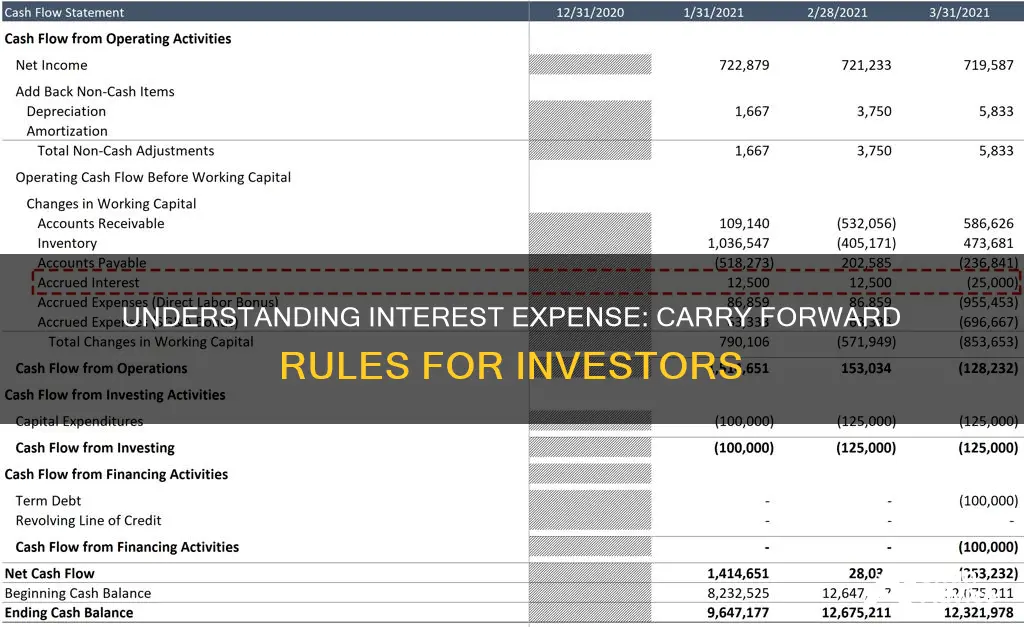
Investment interest expenses can be carried forward to future tax years. The amount that can be carried forward is the amount that exceeds your deductible amount. This can be calculated using Form 4952, which is divided into three sections: calculating your total investment interest expense, determining your net investment income, and figuring out any disallowed investment expense that can be carried forward.
| Characteristics | Values |
|---|---|
| Can investment interest expense carry forward? | Yes |
| How much can carry forward? | The amount of investment interest expense that exceeds your deductible amount |
| What is the form for this? | Form 4952 |
What You'll Learn

Investment interest expense deductions
To determine your deductible investment interest expense, you need to know your net investment income, which normally includes ordinary dividends and interest income. It does not include investment income taxed at the lower, long-term capital gains tax rates or municipal bond interest, which is not taxed at all.
You also need to know your total investment interest expenses for loans used to purchase taxable investments. For example, if you have $3,000 in margin interest but net investment income of only $1,000, you can only deduct the $1,000 in investment interest in the current year. The IRS does allow you to carry forward the disallowed deduction into future years, however. In this case, you can use the $2,000 in disallowed expenses for this year in a future year, but the same restrictions continue to apply.
Not all interest you pay on investment loans is allowed as a deduction. The IRS specifically prohibits certain types of investment interest from qualifying, including interest used to generate tax-exempt income, such as if you go on margin to buy a municipal tax-free bond, and option straddles, which are an advanced investment strategy not applicable to most investors.
Invest Wisely, Live Comfortably Off Your Interest
You may want to see also

Net investment income
To calculate your net investment income, you need to include ordinary dividends and interest income. It does not include investment income taxed at the lower, long-term capital gains tax rates or municipal bond interest, which is not taxed.
Your net investment income determines the amount of investment interest expense you can deduct. For example, if your net investment income is $1,000 and your investment interest expense is $3,000, you can only deduct $1,000 in the current year. The remaining $2,000 in disallowed expenses can be carried forward to a future year.
It's important to note that not all interest you pay on investment loans is allowed as a deduction. Certain types of investment interest are specifically prohibited by the IRS, such as interest used to generate tax-exempt income or option straddles, an advanced investment strategy.
Understanding Investment Interest: How to Make Your Money Work
You may want to see also

Disallowed expenses
The amount of investment interest expense that exceeds your deductible amount can be carried forward to future tax years. However, the rules for calculating investment interest expense deductions can be complicated. For example, you might not be able to use the investment interest deduction if you're subject to the Alternative Minimum Tax (AMT). Only certain types of investment interest qualify for the deduction, and the amount that you can deduct is limited to the amount of your net investment income.
- Loan repayment: Personal loans (even if they are to help run your business) and overdrafts count as disallowable expenses.
- Clothing: Everyday clothing or attire is considered a disallowable expense.
- Asset depreciation: Costs incurred to manage the depreciation of assets like cars and other work equipment are classed as disallowed expenses.
- Fines and penalties: This includes all the costs you incur due to breaking the law. Examples include parking fines and VAT penalties.
- Donations: Any donations you make to charities, clubs, or political parties, are considered disallowed expenses.
- Entertainment expenses: This includes entertainment, gifts, and hospitality you offer to clients, customers, or suppliers.
Unlocking Compound Interest: Smart Investments for Long-Term Growth
You may want to see also

Tax-exempt income
The amount of investment interest expense that exceeds your deductible amount can be carried forward to future tax years. This is typically done using Form 4952, which is divided into three sections. Part I calculates your total investment interest expense, Part II determines your net investment income, and Part III calculates any disallowed expense that can be carried forward to future years.
The amount that you can deduct is capped at your net taxable investment income for the year. Any leftover interest expense gets carried forward to the next year and can be used to reduce your taxes in the future. To determine your deductible investment interest expense, you need to know your net investment income, which normally includes ordinary dividends and interest income. It does not include investment income taxed at the lower, long-term capital gains tax rates or municipal bond interest, which is not taxed at all.
Not all interest you pay on investment loans is allowed as a deduction. The IRS specifically prohibits certain types of investment interest from qualifying, including interest used to generate tax-exempt income, such as if you go on margin to buy a municipal tax-free bond.
One of the most common examples of investment interest expense involves the use of a margin loan at a brokerage. If you "go on margin" with your stockbroker, it means you are borrowing money from the firm to buy stocks or other investments.
Compounding Interest: Annual vs. Quarterly, Which is Better?
You may want to see also

Investment interest expense and the Alternative Minimum Tax (AMT)
Investment interest expenses can be carried forward to future tax years. However, the Alternative Minimum Tax (AMT) could completely disallow the use of your investment interest deduction. The AMT is designed to ensure that certain individuals pay at least a minimum amount of tax by adding back in items that may have been excluded from a traditional tax calculation. Investment interest is one of those deductions disallowed under the AMT.
The IRS allows certain taxpayers to take a tax deduction for the interest expense on some loans using Form 4952. The form requires you to calculate your total investment interest expense, determine your net investment income, and figure out any disallowed investment expense that can be carried forward. However, only certain types of investment interest qualify for the deduction, and the amount that you can deduct is limited to the amount of your net investment income.
The instructions for Form 4952, "Investment Interest Expense Deduction," and Form 6251, "Alternative Minimum Tax—Individuals," instruct taxpayers on how to compute the correct taxes under both systems. Ultimately, whichever of your Form 4952s shows the higher tax is the one you will have to file with the IRS.
One of the most common examples of investment interest expense involves the use of a margin loan at a brokerage. If you go on margin with your stockbroker, it means you're borrowing money from the firm to buy stocks or other investments.
Investments: Understanding Compound Interest and Earnings
You may want to see also
Frequently asked questions
Form 4952 is a short form used to calculate the amount of investment interest expense you can deduct for the current year and the amount you can carry forward to future years.
The investment interest expense deduction is the amount of investment interest expense that exceeds your deductible amount and can be carried forward to future tax years.
To calculate your deductible investment interest expense, you need to know your net investment income, which normally includes ordinary dividends and interest income. It does not include investment income taxed at the lower, long-term capital gains tax rates or municipal bond interest, which is not taxed at all. You also need to know your total investment interest expenses for loans used to purchase taxable investments.
The amount you can deduct is capped at your net taxable investment income for the year. Any leftover interest expense gets carried forward to the next year and can potentially be used to reduce your taxes in the future.







